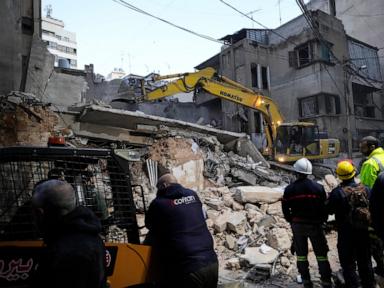ARTICLE AD BOX
ON the front line, a desperate shortage of shells is forcing Ukraine’s big guns to fall silent.
But whirring overhead, armed with improvised bombs, is an airborne force striking terror into the enemy — the Vampire drones.
 Peter Jordan
Peter Jordan Peter Jordan
Peter JordanRussian troops fear them so much they call them Baba Yaga, a child-eating witch from fairy tales.
They are part and parcel of modern warfare, fought remotely, much like a video game, and plugging the gaps in Ukraine’s firepower on the 600-mile front line.
Cheap, deadly and easy to use, drones have let both sides blast targets behind the front lines at a fraction of the price of air-launched bombs and guided missiles.
Ukraine has vowed to build a million UAVs this year in recognition of their war-winning role.
The Sun joined the drone bombers blitzing Russian trenches, scrambling to the launch site on Ukraine’s north eastern front in a convoy of 4x4s in darkness.
Drivers steered across frozen tracks without headlights, relying instead on the light of the moon to avoid attracting a attention.
The destination was an abandoned farm.
Within minutes of arriving a well-drilled team transformed it into a temporary airfield — erecting a 20ft antenna and establishing lightning fast communications via a Starlink satellite internet terminal.
Team leader Artem, 40, put the Vampire’s controls in a cellar that became his command bunker.
His comrades, Maksim, 31, and Andrii, 36, assembled the bombs in the farmhouse, using gaffer tape, glue and cable ties to fit the parts together.
In the fields outside they worked by red torchlight to stay hidden from Russian spotters.
Maksim, a former coal miner, loaded the patched-together bombs on to a Vampire’s undercarriage then slowly inserted the firing pins and removed the sugar lump-size safety chocks that prevent them going off early.
Within 40 minutes of arriving their Vampire drone was armed and whirring over frozen forests towards Russian positions in Kupiansk.
Moscow’s troops have been trying for months to retake the district having been forced to retreat by a lightning assault 18 months ago.
They advanced a kilometre over the winter, paying a heavy price in soldiers’ lives — up to seven times the losses among the defenders.
But the shortage of heavy artillery shells has made it harder to stall advances by Vladimir Putin’s forces.
Lt Ivan, 43, a former magazine editor, said drones such as the Vampire were vital. “We are rationing our artillery, so we can’t kill as many Russians.
It’s like a computer game but with no extra lives and you can’t save the game
Andrii, former air-conditioning engineer“We can’t hold as many positions,” he added.
“But luckily the drone teams have really learned how to close the gaps on the front line.”
The Vampires are made in Ukraine, they cost less than a second-hand car and are crowd-funded by Ukraine’s Army of Drones initiative.
The bombs they drop are a mixture of anti-tank grenades and 3D printed mortars packed with shrapnel and explosives.
And the six-engined Vampires, about the size of a coffee table, average 50 flights with up to four bombs on each sortie before they break or are destroyed.
Artem, a shopkeeper before the war, said they flew theirs only at night to avoid it being shot down.
We watched as their Vampire reached its first target, a well-built dug out in forest, covered with tree-trunks and earth.
 Peter Jordan
Peter JordanLive feeds from the thermal camera showed the bombs drop one by one, erupting in the crosshairs in a blaze of white light on the screens in the bunker.
Their second target was a Russian mortar position — but when the Vampire reached the target its camera feed suddenly failed.
Artem dropped the bombs on the target but only saw one explode in a heavily pixelated picture.
Andrii, a former air-conditioning engineer, said: “It’s like a computer game but with no extra lives and you can’t save the game.”
But Artem has no reservations about killing his enemies like that.
He said: “Especially when they kill our guys.
“We need to take revenge.”
Cold War museum manuals fix tanks
A TANK museum in Dorset is helping to repair Cold War-era vehicles for the war on Russia.
Old manuals and diagrams were dug out from its archive and passed to a defence manufacturer.
It meant the firm could make parts for Ukraine’s Soviet-made tanks from the 1960s and ’70s to repair caterpillar tracks damaged by mines.
David Willey, curator of the 300-vehicle museum in Bovington, said: “UK defence companies are very keen to assist, but in some cases the people are no longer around and knowledge has been lost.
“Details such as the angles, pitch and tension required for the new tracks were sought and our archive was able to provide them with old manuals and blueprints.
“We also found examples of the actual items required, such as T-72 tracks and pins.
“We’re duty-bound to help Ukraine. If we don’t stand up to Putin, other countries will be next.”
William Cook, from Durham-based Cook Defence Systems which built the parts, added: “There are Ukrainian soldiers on the front line whose lives depend on what we do.”
Weapon guru ‘hit’ by Kyiv
By Will Stewart
RUSSIA has blamed Ukraine for an assassination attempt on one of Vladimir Putin’s top weapons designers.
A Molotov cocktail was thrown at the home of Valery Kashin, 76, in Kolomna, near Moscow.
But it failed to ignite and no one was hurt.
A Moscow man Roman Nerobelov, 28, has been arrested on a charge of attempted murder.
He told police he received a call telling him his £13,000 debts would be erased if he threw the bomb.
Authorities say “scammers in Ukraine” are behind the attack.
Kashin designed anti-tank, anti-aircraft and high-precision missiles including the Iskander-M.
Nerobelov could face up to 15 years in prison.
 Artem dropped the bombs on the target but only saw one explode in a heavily pixelated picture
Artem dropped the bombs on the target but only saw one explode in a heavily pixelated picture.png)
 8 months ago
4
8 months ago
4








 English (US)
English (US)